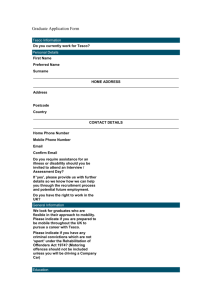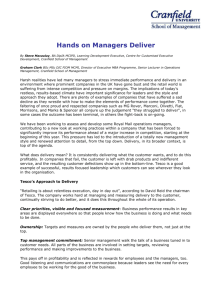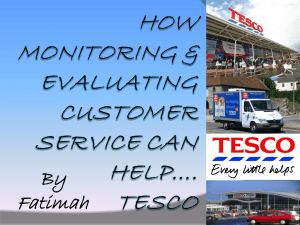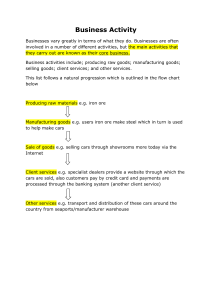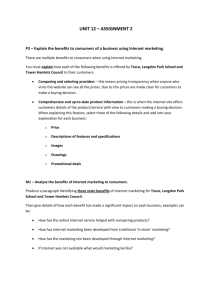In the supermarket
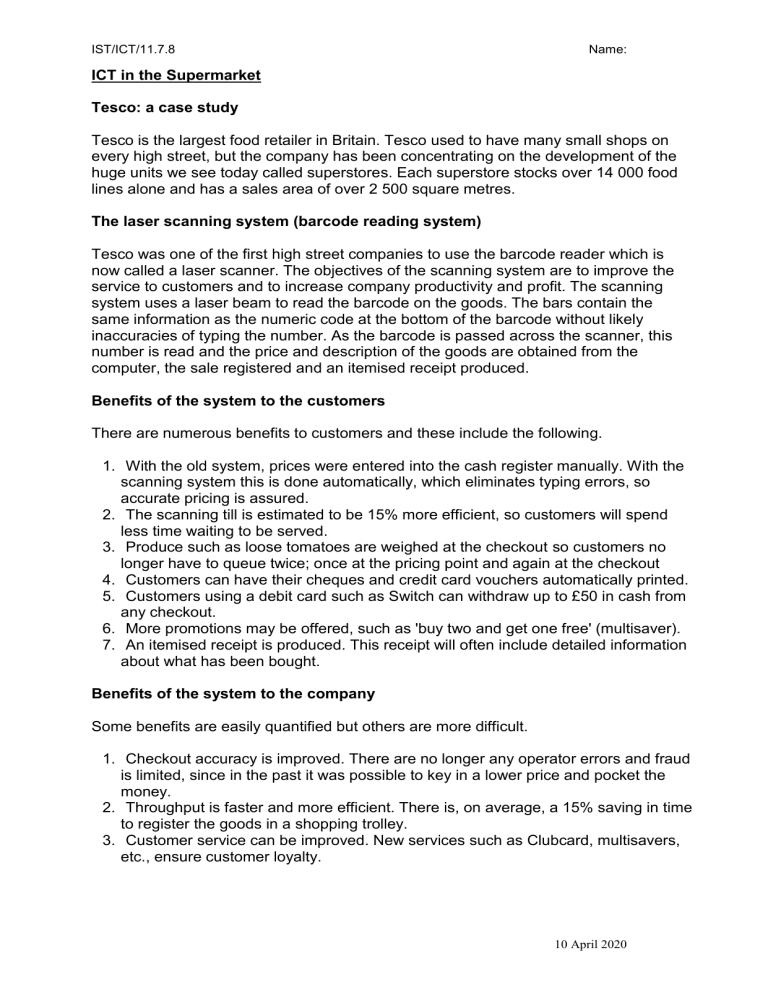
IST/ICT/11.7.8 Name:
ICT in the Supermarket
Tesco: a case study
Tesco is the largest food retailer in Britain. Tesco used to have many small shops on every high street, but the company has been concentrating on the development of the huge units we see today called superstores. Each superstore stocks over 14 000 food lines alone and has a sales area of over 2 500 square metres.
The laser scanning system (barcode reading system)
Tesco was one of the first high street companies to use the barcode reader which is now called a laser scanner. The objectives of the scanning system are to improve the service to customers and to increase company productivity and profit. The scanning system uses a laser beam to read the barcode on the goods. The bars contain the same information as the numeric code at the bottom of the barcode without likely inaccuracies of typing the number. As the barcode is passed across the scanner, this number is read and the price and description of the goods are obtained from the computer, the sale registered and an itemised receipt produced.
Benefits of the system to the customers
There are numerous benefits to customers and these include the following.
1. With the old system, prices were entered into the cash register manually. With the scanning system this is done automatically, which eliminates typing errors, so accurate pricing is assured.
2. The scanning till is estimated to be 15% more efficient, so customers will spend less time waiting to be served.
3. Produce such as loose tomatoes are weighed at the checkout so customers no longer have to queue twice; once at the pricing point and again at the checkout
4. Customers can have their cheques and credit card vouchers automatically printed.
5. Customers using a debit card such as Switch can withdraw up to £50 in cash from any checkout.
6. More promotions may be offered, such as 'buy two and get one free' (multisaver).
7. An itemised receipt is produced. This receipt will often include detailed information about what has been bought.
Benefits of the system to the company
Some benefits are easily quantified but others are more difficult.
1. Checkout accuracy is improved. There are no longer any operator errors and fraud is limited, since in the past it was possible to key in a lower price and pocket the money.
2. Throughput is faster and more efficient. There is, on average, a 15% saving in time to register the goods in a shopping trolley.
3. Customer service can be improved. New services such as Clubcard, multisavers, etc., ensure customer loyalty.
10 April 2020
IST/ICT/11.7.8 Name:
4. Productivity is increased. There is no need to price each individual article, as in the past. Prices are included on the edges of the shelves next to the articles. Weighing and pricing at the checkouts eliminates the need for separate pricing points.
5. Sales information from the checkout is used to create the orders for stock replacement.
6. Stock levels can be reduced. More efficient stock control means less money tied up in stock and less likelihood of running out of certain items on the sales floor.
7. Wastage is also reduced. Perishable goods such as fresh meat and salads can be ordered accurately using the sales information obtained from the checkout.
8. Promotional analysis and sales analysis are improved. Scanning data can be used to assess the effectiveness of special promotions and can provide important information about the sales of certain goods.
The barcoding system
The picture below shows a barcode from a tin of Heinz baked beans.
The number at the bottom is called the European Article Number (EAN); a number is allocated to all product manufacturers by the Article Number Association. The system works as follows:
the first two digits represent the country where the goods are produced
the next five digits identify the manufacturer of the goods
the following five numbers identify the product
the final number is a check digit and is used to check that the other 12 numbers have been entered correctly.
EFTPOS and the use of debit cards
EFTPOS stands for electronic funds transfer at point of sale and is the method used by
Tesco to transfer money from customers' credit card companies or debit cards directly to the Tesco bank account. A debit card is rather like a cheque, since the money comes straight out of the bank account. However, there is no limit to the amount you can spend using one of these cards, provided that you have the money in your account. This is in contrast to cheques where there is a limit (usually £50 or £100) to the value of the cheque that is covered by the guarantee card.
Using checkout information for planning bakery production
10 April 2020
IST/ICT/11.7.8 Name:
Sales information from checkouts is used by in store bakeries to plan the production for the same day for the next week. This reduces wastage and means stores are less likely to run out of bread.
Sales based ordering
Sales based ordering is the automatic re ordering of goods from the warehouse using the sales information from the checkouts. If, for example, 200 tins of baked beans are sold from a certain store in one day, then 200 tins will be automatically re ordered and delivered to the store the following day from one of the Tesco distribution centres.
The large articulated vehicles you see are specially constructed: they have compartments which can be kept at different temperatures, so, for instance, chilled food, frozen food and other types of food which do not need cooling may be carried in the same vehicle.
Stock control
All ordering is performed by computer. There are fast electronic communication lines between the shops, the distribution centres and the head office. There are also direct links to the major suppliers, which means that orders can go straight through to production lines. One advantage of this is that stock arrives just in time before sale so it is always fresh. Another advantage of this system is that money does not need to be tied up in stock and can be used for more productive purposes.
Electronic shelf labelling
Tesco is developing a system with liquid crystal shelf labels containing the price, description and ordering information about goods. The label is operated from the computer using radio signals and this avoids human error, where a price change on the computer is not transferred to the shelf. This means that changing a price on the computer database and shelf can be done at the same time so the price stored and that on the shef will always be the same.
Electronic data interchange (EDI)
Electronic data interchange is a method of speeding up the transfer of orders to suppliers. Using EDI eliminates the need for paperwork, since the ordering is done by data being transferred between the supplier's computer and Tesco's computer. This system is less expensive and faster than sending the orders by phone, post or fax and cuts out errors, such as lost or wrongly printed orders. Tesco can send information to suppliers regarding sales forecasts and information about stock levels so that they may plan the production appropriately.
Once an electronic order has been placed the electronic invoice is generated automatically by the supplier's computer. This is sent back and checked by the Tesco computer before payment is made.
Tesco: the hardware
We have looked at the systems in use by Tesco. As you can imagine, the computers running these types of operations are some of the most sophisticated and powerful
10 April 2020
IST/ICT/11.7.8 Name: computers in the world. The mainframe computers are situated in two computer centres and each is capable of running the company's systems on its own. The computers are capable of delivering 216 MIPS (million instructions per second) and are the fastest commercial computers in the UK.
Since computers are so vital to Tesco's operations, there are backup procedures in place so that even if one of the computer centres were completely destroyed, the other would be able to re establish the vital systems within 48 hours. The backup procedures are tested each year so that staff know exactly what to do if a disaster were to occur.
Designing store layouts using CAD it is no longer necessary to use drawing boards for planning new stores and re designing existing ones. Instead, computer aided design (CAD) is used and this has reduced the time taken to plan new stores. A databank holds designs and plans from many stores and these may be adapted for new stores. CAD is also able to show three dimensional views of the stores; colours, lighting and different finishes of material can be altered simply with a mouse.
When a new store is to be placed in an existing high street, photographs of the existing shops in the street can be used in conjunction with CAD to see what the street will look like with the Tesco front in place.
CAD is also used to design warehouse layouts ' the roads and the surrounding areas around the distribution centres. This is important since the company needs to make sure that there is ample room for the large articulated vehicles to turn round.
Warehouse systems
Computers are used in the warehouse to monitor complex stock control procedures and make the best use of space, time and labour. Like all areas of retailing, better operating methods need to be found to ensure Tesco's continued success. As with all the other systems, paperwork has been eliminated wherever possible, so the thick binders containing stock items are replaced by computer terminals. In fact, these terminals can be found mounted on fork lift trucks; they give the operators information regarding the movement of the pallets so that they may be moved quickly and efficiently. If some stock goes out of the warehouse then a slot is available for the new stock arriving and notification of this is obtained from the terminal. Efficient use of the available space means that the trucks have to travel shorter distances and the whole process is therefore faster.
The computer system also monitors where each fork lift truck is situated in the warehouse so that a particular job can be given to the fork lift truck best able to complete it in the least amount of time.
Electronic mail
Tesco, like a lot of forward looking companies, has realised the benefits of using electronic mail. With conventional methods of communication there are many problems, such as lost post, unanswered telephones, engaged fax machines, people not at their desks, etc. To try to contact someone urgently during office hours can be more difficult than you think. Electronic mail eliminates many of these problems. The store system used by Tesco uses a series of standard forms, so memos, letters, reports, etc. all have a set format. Advantages to Tesco in using electronic mail include:
10 April 2020
IST/ICT/11.7.8 Name:
1. The recipient does not need to be there when the message is sent; he or she can receive mail at any terminal connected to the system. Compare this with a telephone call where someone needs to be available to answer the call.
2. People can be sure that the messages are received.
3. It is possible to send mail to a department or a group of people. Anyone in the company can send mail to a whole department without knowing anyone in the department by name.
4. The electronic mail system is used as a company information and notice board.
Members of staff can find out about the latest job vacancies and appointments, and look at the latest share price.
5. Electronic mail can be sent to the major suppliers, thus speeding up orders, etc.
Questions
1. Why is an item’s price not held in the numeric code?
2. [Research] What is self-scanning?
3. Sort the customer benefits of barcode scanning into order of importance.
4. Do the same for the benefits to Tesco
5. Are there any dangers with EFTPOS?
6. List the ways the computer system helps with stock control.
7. What are the benefits and risks to Tesco of using e-mail?
10 April 2020

